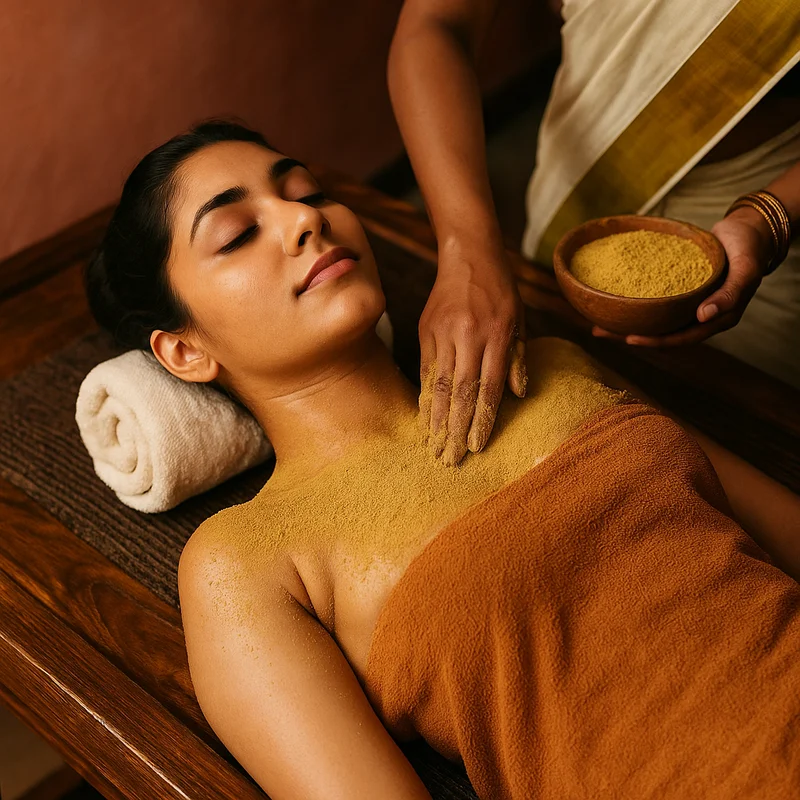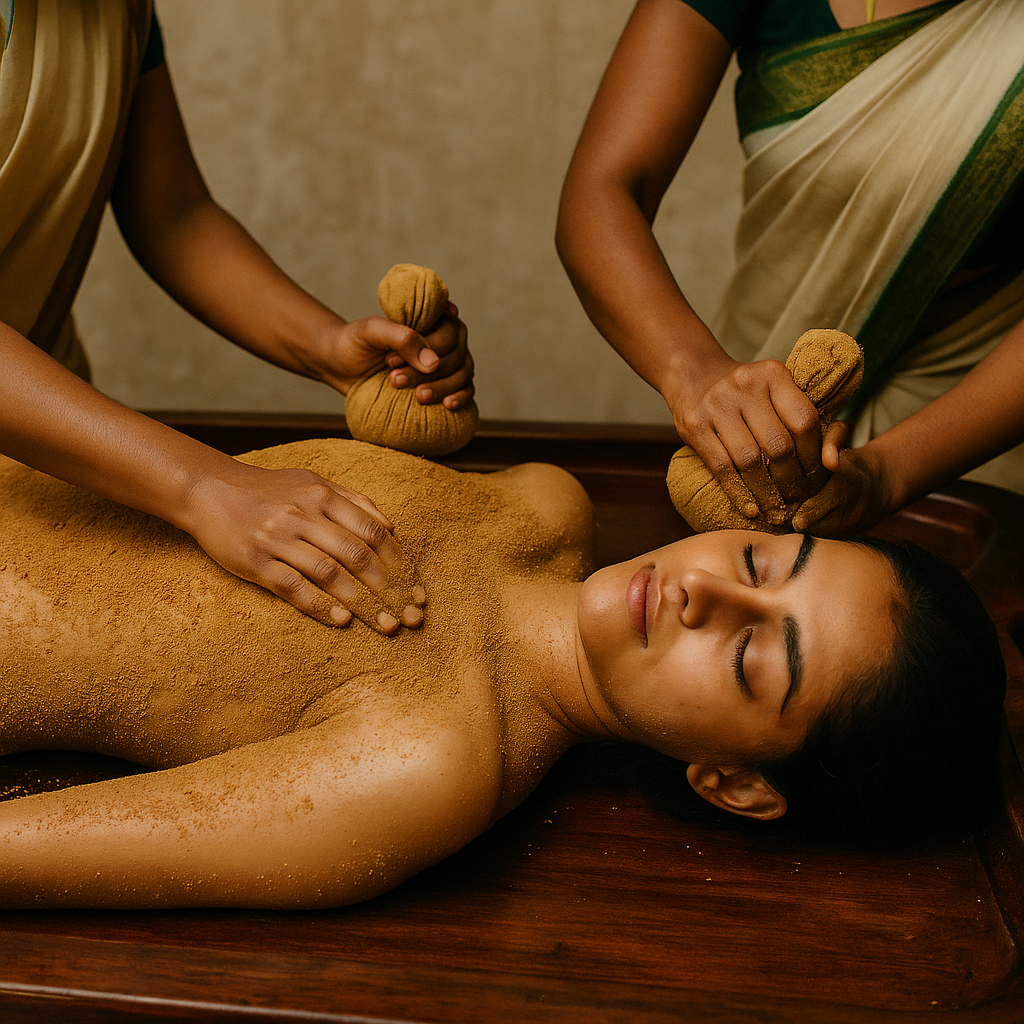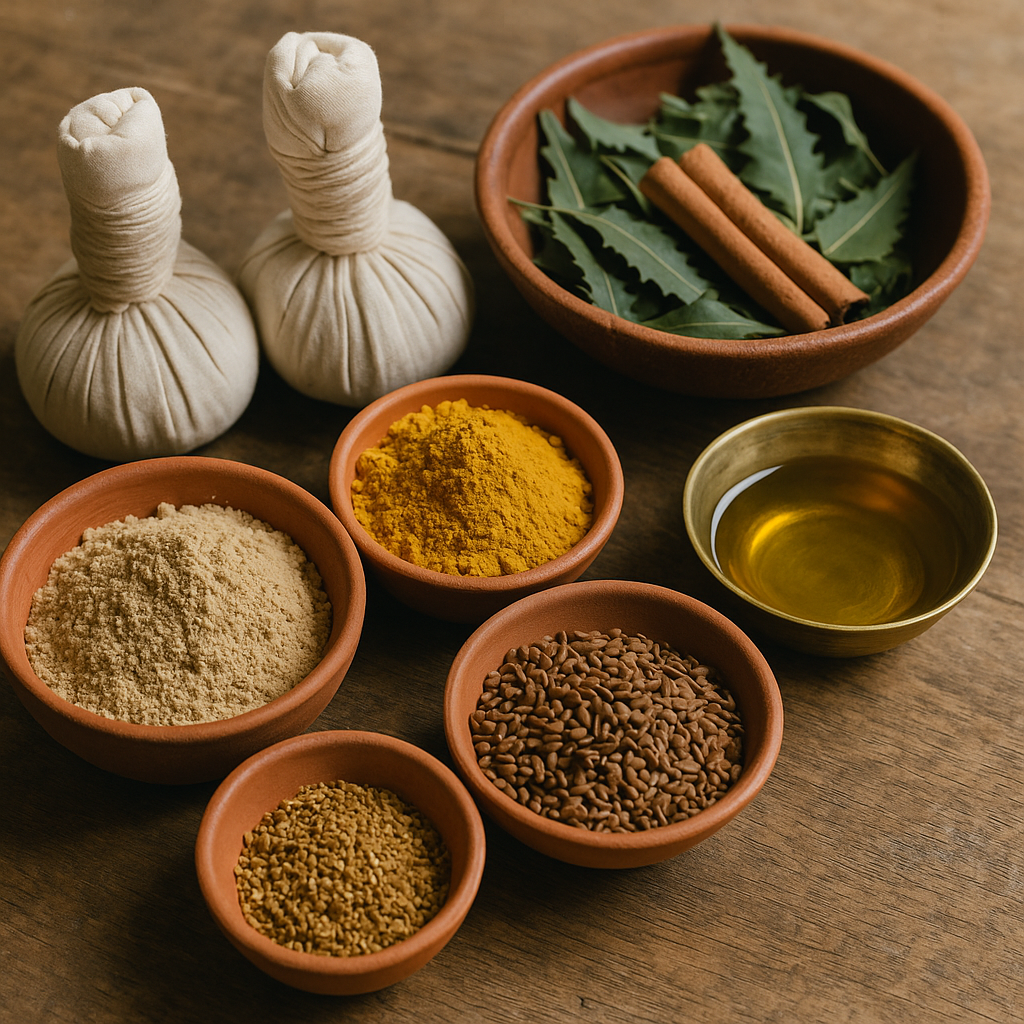Ask Ayurvedic doctor a question and get a consultation online on the problem of your concern in a free or paid mode. More than 2,000 experienced doctors work and wait for your questions on our site and help users to solve their health problems every day.
Shop Now in Our Store
Udwarthanam: The Ayurvedic Powder Massage That’s More Than Just Detox

Introduction to Udwarthanam
Let’s say you’ve tried the oils, the steam, the yoga, the bitter herbal teas. And yet — you still feel heavy. Foggy. Like your skin’s wearing a layer of clingwrap from the inside. That’s where Udwarthanam comes in.
Udwarthanam (also spelled Udvartana) is a deeply invigorating Ayurvedic dry powder massage. Unlike your typical spa massage — all soft strokes and glistening oils — this one’s more of a firm, gritty, circulation-boosting scrubdown. Think of it as a cross between lymphatic drainage, exfoliation, and metabolic wake-up call. No candles, no flute music. Just warm herbal powders rubbed vigorously into your body — in upward, stimulating strokes — until your skin tingles and your tissues feel alive.
Now, let’s place this in the larger picture of Ayurveda. In the Ayurvedic system, everything is about balance — especially the balance of the three doshas: Vata, Pitta, and Kapha. Udwarthanam is particularly powerful against stubborn Kapha imbalances — heaviness, lethargy, water retention, dullness, and sluggish metabolism. That "stuck" feeling? Kapha. And this therapy is like nature’s reboot button for it.
But it’s not just for the sluggish. Udwarthanam is also used for:
-
Weight management and reducing cellulite
-
Improving skin texture and tone
-
Enhancing blood circulation and lymphatic drainage
-
Aiding in diabetes management and hormonal balance
-
Boosting energy and alertness
This article is here to tell you everything you need to know. Not just the pretty, brochure-ready version — but the whole picture. The history, the how-to, the herbs, the caveats, and even real people’s stories. And not just because it’s “ancient wisdom” — but because it actually works for a lot of modern-day issues, when applied with care.
So if you’re curious about why your Ayurvedic practitioner might prescribe you a powder massage instead of a calming oil session — or if you’ve been wondering whether this is just a fancy body scrub — stick around. You’ll leave with real insight. And maybe the urge to book an appointment.

History and Origin of Udwarthanam
Historical Background and Roots of Udwarthanam
The idea of rubbing medicinal powders into the skin might sound contemporary, maybe even trendy — but Udwarthanam is old. Really old. As in: classical-Ayurveda-texts-and-handwritten-palm-leaf-manuscripts old.
Historically, Udwarthanam evolved as one of the many “Shamana” therapies — procedures intended to pacify aggravated doshas without purging or evacuating the body. The earliest roots trace back to the Vedic period, where references to body scrubbing using herbal pastes and powders are hidden in hymns and health rituals.
But its practical application as a structured therapeutic massage began solidifying in the Samhita period, around 1500 BCE to 500 CE. Ayurveda’s three foundational texts — the Charaka Samhita, Sushruta Samhita, and Ashtanga Hridayam — all mention forms of friction-based massage and powder application for various disorders, especially those linked to Kapha dosha, obesity, and metabolic sluggishness.
And here’s the fun part: unlike many classical Ayurvedic procedures that were limited to royalty or the ill, Udwarthanam had a dual life. It was both medicinal and cosmetic. Historical records and folk traditions show that brides-to-be in ancient Kerala underwent Udwarthanam for 10-14 days before their weddings to enhance skin glow and detox the body. Not unlike how people book spa facials before a big event today.
Ayurvedic Textual References about Udwarthanam
Let’s get a little textual for a second. The Ashtanga Hridayam, attributed to Vagbhata, describes Udwarthana as a dry massage that removes Kapha toxins, liquifies fat, and firms the body. The Sanskrit verse literally says:
“Utsadanam Kapha-Haram Medasah Pravilapanam | Srotoshodhanam Anganam Sthirata Kriya Udwarthanam”
Translation? “Udwarthanam is the act of rubbing powders over the body to eliminate Kapha, liquefy fat, purify the channels, and promote firmness.”
Sushruta, known as the father of surgery, also documented a similar practice for obese individuals, emphasizing the scraping and stimulating nature of the powder application.
Interestingly, Udwarthanam was also seen as a preparatory step before more intense Ayurvedic detox procedures like Panchakarma. Basically: loosen the toxins first, then purge them out. Smart.
Traditional Use and Evolution of Udwarthanam
Over the centuries, Udwarthanam branched into two main types:
-
Snigdha Udwarthanam (with oils)
-
Ruksha Udwarthanam (dry powder)
The choice between them depends on your body type and health goals. While Ruksha is more aggressive and detoxifying (often used for obesity, diabetes, and Kapha imbalance), Snigdha is gentler, suited for people with dryness or Vata dominance.
It was widely practiced across Kerala, Tamil Nadu, Karnataka, and Sri Lanka, not just in formal Ayurvedic clinics but also in village households. Grandmothers would rub warm powders on their grandkids during the monsoon to improve immunity. Midwives would recommend it postpartum to help with water retention and lymph drainage. There was even a “mini” version of Udwarthanam done just on the feet or joints for arthritis relief.
What’s wild is how relevant all this still feels today. We talk about lymphatic drainage, metabolic boosting, and fat mobilization as if they’re modern biohacks — but Ayurveda’s been doing it with herbs and hands for over 2000 years.
So What’s the Point? (And Why Do People Swear by Udwarthanam?)
Physical Health Benefits of Udwarthanam
Let’s be blunt. Most people don’t sign up for Udwarthanam because they’re seeking spiritual elevation — they want to feel lighter. Maybe it’s that post-holiday bloating, maybe it’s stubborn cellulite that’s overstayed its welcome, or maybe it’s a sense that your body just isn’t circulating right. Whatever the reason, this therapy delivers a very physical response.
A few physical perks you can realistically expect:
-
Improved circulation – The upward strokes activate the blood and lymph flow. I’ve had someone tell me they felt “buzzing” in their limbs for hours afterward.
-
Exfoliated skin – Herbal powders can be gently abrasive, helping slough off dead cells and unclog pores.
-
Reduced water retention – Especially in the legs and arms. The stimulation encourages the lymphatic system to do its job.
-
Fat mobilization – Not fat loss per se, but fat that’s just... stuck. Udwarthanam heats things up and gets things moving.
-
Better digestion and metabolism – This sounds odd, but I swear it happens. After a session, people often report less bloating, faster hunger signals, even improved elimination.
Mental and Emotional Benefits of Udwarthanam
Okay, so here’s where things get a little less measurable and a lot more felt. Udwarthanam isn’t typically classified as a “soothing” treatment. It’s not like Shirodhara with the dripping oils and meditative calm. But in its own way, it clears mental fog.
There’s something about the vigorous nature of it — the friction, the heat, the motion — that shakes up your emotional state. Clients sometimes say they feel awake again. Not just physically, but mentally. I've had one woman tell me it felt like someone “dusted the cobwebs off her brain.”
It’s energizing. Clarifying. You walk out less sleepy and more intentional.
How Udwarthanam Balances the Doshas (Vata, Pitta, Kapha)
This is where things really get Ayurvedic.
-
Kapha: This is Udwarthanam’s main target. Kapha’s heavy, slow, sticky. Udwarthanam is dry, hot, and invigorating. Perfect antidote. It reduces excess weight, stagnation, and puffiness — textbook Kapha clearing.
-
Vata: Tricky. If Vata is already high (think dry skin, anxiety, cracking joints), a dry Udwarthanam might worsen things. In such cases, the Snigdha (oily) version is used instead, or skipped entirely.
-
Pitta: It can go either way. If there’s inflammation or skin sensitivity, caution is key. But in a balanced state, Udwarthanam can help Pitta types feel less stuck and more fluid.
In short: it’s great for Kapha, conditional for Pitta, and gentle only for Vata.
How It’s Done: A Step-by-Step Look at Udwarthanam
Preparation for Udwarthanam Procedure
Don’t just walk in from traffic and flop on the table.
Traditional prep for Udwarthanam involves:
-
Assessment of your prakriti (constitution) and current doshic state.
-
Fasting or light meals beforehand — it’s best not to eat for at least 1-2 hours.
-
Mild steam therapy or abhyanga (oil massage) sometimes comes before, to loosen up tissues.
-
Selecting the right powder blend — this isn’t one-size-fits-all. More on that in the next section.
Pro tip? Pee before. It’s not the most relaxing treatment, and the last thing you want is bladder pressure mid-massage.
Step-by-step Guide of Udwarthanam Procedure
Here’s what the procedure typically looks like:
-
Client lies down on a wooden or Droni table, often covered in cloth or banana leaves.
-
Dry herbal powder (or oil + powder) is applied warm.
-
Massage begins — always upward strokes, going against hair growth. This is key. It’s stimulating, not soothing.
-
Targeted pressure — not just random rubbing. Each stroke is timed, sequenced, and firm.
-
The whole body is covered, including limbs, back, abdomen — sometimes even face and chest.
-
After 30–45 minutes, the massage ends.
-
Steam bath (Swedana) is often used after, to open up channels and sweat out loosened toxins.
-
Final wash-off with warm water and a towel.
It’s intense. Don’t expect to nap through it. But many walk out feeling surprisingly light.
Duration and Frequency Recommendations for Udwarthanam
This depends on your reason for doing it. A few guidelines:
-
Single session: Great for skin glow, energy boost, pre-event prep.
-
7-day series: Ideal for detox or metabolism reset.
-
14–21-day course: For chronic issues like obesity, PCOS, or insulin resistance — always under expert guidance.
Each session runs about 45–60 minutes.
The Ingredients: What’s Actually in That Powder?
Key Herbs and Oils Essential for Udwarthanam
The exact formulation varies, but here are the classics:
-
Kola (Ziziphus jujuba) – Astringent, exfoliating
-
Vacha (Acorus calamus) – Improves circulation and melts stagnation
-
Haritaki (Terminalia chebula) – Detoxifying, slightly laxative
-
Chitraka (Plumbago zeylanica) – Boosts metabolism, quite hot
-
Triphala – You probably know this one. All-around healer.
-
Mustard or sesame oil – In Snigdha versions
Often these are ground into fine powders or mixed with oil, depending on your constitution.

Benefits and Roles of Specific Ingredients in Udwarthanam
This isn’t just exfoliation for the sake of it. Each ingredient brings something specific:
-
Chitraka heats up and targets sluggish Kapha
-
Triphala gently scrubs but also rejuvenates
-
Turmeric (in some versions) brings anti-inflammatory action and glow
-
Vacha breaks down fat and removes ama (toxins)
In a way, the powder is like an external herbal medicine — absorbed through skin, lymph, and sweat.
Where and How to Source Quality Ingredients for Udwarthanam
If you’re doing this at home (some people do), please don’t just grab turmeric from your spice rack.
Look for:
-
Certified Ayurvedic suppliers (ex: Kottakkal Arya Vaidya Sala, AVP, or local vaidyas)
-
Organic herbs — they matter here, because the skin will absorb what you apply
-
Pre-made Udwarthana churna (powder) mixes from trusted clinics
And always check shelf life. Old powders lose potency and can irritate.
Indications and Contraindications: Who Is (and Isn’t) Udwarthanam For?
Health Conditions and Symptoms Indicating Udwarthanam
You should consider Udwarthanam if you experience:
-
Obesity or unexplained weight gain
-
PCOS / hormonal imbalances
-
Water retention / puffiness
-
Dull skin, body odor, sluggish sweat
-
Mental fog and fatigue
-
Mild depression or Kapha-type lethargy
It’s also used during:
-
Postpartum care (under guidance)
-
Pre-wedding beauty routines
-
Pre-Panchakarma prep — to mobilize toxins
Potential Risks and Contraindications of Udwarthanam
It’s not for everyone. Avoid or rethink if:
-
You have very dry or sensitive skin
-
You’re pregnant or breastfeeding
-
There’s active inflammation, rashes, or wounds
-
You’re running a fever or have acute illness
-
You’re underweight or have high Vata
And honestly? If you’re mentally not in a space for vigorous bodywork, don’t force it.
Who Should Avoid Udwarthanam or Seek Expert Advice
When in doubt, ask a vaidya. Especially if you:
-
Are taking medication for diabetes or thyroid — Udwarthanam can interact with energy levels
-
Have autoimmune conditions
-
Are over 70 or under 16
-
Have cardiac concerns
Bottom line: it's therapeutic — not a spa gimmick. Treat it with that respect.
What Happens After Udwarthanam? (And How Not to Ruin the Results)
Recommended Lifestyle Adjustments After Udwarthanam
You just had a full-body, dry-herb massage that pushed your circulatory and lymphatic systems into overdrive. So… what next?
This part matters way more than people think.
Immediately post-treatment:
-
Rest. Like, for real. You just did internal spring cleaning — don’t rush into emails or workouts.
-
Avoid cold exposure. No cold showers, AC blasts, or chilly foods.
-
Stay hydrated, but avoid icy drinks. Warm herbal teas or lukewarm water are best.
For the next 1–2 days:
-
Sleep early. Your body is recalibrating.
-
Don’t fast or overeat. Keep it light but consistent.
-
Mild movement. A short walk is fine. HIIT? Not so much.
It’s not about doing more — it’s about letting the therapy integrate.
Diet and Nutrition Guidelines Following Udwarthanam
This is where Ayurveda goes from ancient wisdom to absurdly practical. Your digestive fire (Agni) is a little vulnerable post-treatment, so go easy.
Ideal post-therapy foods:
-
Kitchari (mung + rice + ghee) — classic for a reason
-
Cooked vegetables (carrots, squash, spinach)
-
Herbal teas (ginger, cumin, fennel)
-
Warm, nourishing soups
Avoid:
-
Ice cream, soda, processed snacks (you’ll undo the benefits)
-
Excess raw foods (tough to digest post-massage)
-
Red meat and alcohol for at least 24–48 hours
Trust me — your skin and gut will thank you.
Common Mistakes and Precautions Post Udwarthanam
-
Skipping the steam bath. Big one. You need that sweat to expel loosened toxins.
-
Using commercial soaps afterward. They mess with your skin's absorption and disrupt the herbal benefits.
-
Jumping straight into a workout. Nope. Udwarthanam is already stimulation — don’t stack it.
-
Assuming one session is enough. It might help, yes. But lasting change takes repetition.
Scientific Studies and Modern Research on Udwarthanam
Research Validating the Benefits of Udwarthanam
To be honest, modern research on Udwarthanam is still catching up. But there’s growing curiosity — especially in the fields of obesity, metabolic disorders, and dermatology.
A 2018 clinical paper published in AYU Journal showed measurable benefits of Udwarthanam in reducing body mass index (BMI) and improving lipid profiles in obese women when combined with internal Ayurvedic medication. That’s huge.
Another 2021 pilot study conducted in Karnataka observed increased microcirculation and improved thermoregulation after Udwarthanam — suggesting its effectiveness in lymphatic health and detoxification.
It’s not double-blind placebo-controlled mega trial level yet, but the early signs are promising. And honestly? Ayurveda has been studying this stuff for 2000+ years — just not in the Western academic format.
Clinical Trials and Evidence Supporting Udwarthanam
Here’s a rundown of smaller studies and observations:
-
A 12-week trial combining Udwarthanam with Triphala Guggulu supplementation showed improved waist-to-hip ratios and triglyceride levels.
-
Another trial used it in PCOS patients and found improved insulin sensitivity and cycle regulation.
-
Dermatology researchers are now exploring Udwarthanam as an adjunct treatment for keratosis pilaris and eczema — thanks to its exfoliating and dosha-balancing properties.
Much of the evidence is observational, but the lived results are hard to ignore.
Comparison Between Ayurvedic and Conventional Methods Related to Udwarthanam
Let’s say you’re deciding between:
-
A traditional Udwarthanam course
-
A lymphatic drainage massage at a high-end spa
-
Or a 30-day “cleanse” with pills and shakes
Here’s the thing:
-
Lymphatic massage is great, but usually superficial — doesn’t use herbs, doesn’t address doshic imbalance.
-
Cleanse kits might help, but often lack personalization and aggravate Vata.
Udwarthanam is:
-
Rooted in constitution-specific diagnosis
-
Herbal and non-synthetic
-
Designed to not just remove symptoms but correct underlying imbalances
It’s not always the quickest fix. But in the long game? Ayurveda plays to win.

Real-Life Testimonials and Experiences with Udwarthanam
Patient Stories and Experiences with Udwarthanam
“I thought it was just going to be a scrub. Instead, it was the first time I felt my body ‘wake up’ from years of sluggishness.”
— Neha, 36, after a 7-day course for weight and PCOS
“It wasn’t relaxing, but weirdly, it was what I needed. My skin changed. I sweated for the first time in months.”
— Dev, 42, post-Udwarthanam during Panchakarma prep
“I did Udwarthanam before my wedding. My aunt made me — I rolled my eyes. But my arms looked toned, and my face literally glowed. She was right.”
— Malvika, 28, bridal Udwarthanam
It’s not all roses. One client felt dizzy after her first session — she was dehydrated and hadn’t eaten well. Another said the powder irritated her eczema (wrong formulation).
Results Achieved and Realistic Expectations from Udwarthanam
Let’s keep it real:
-
It won’t melt fat overnight.
-
You won’t float out like a spa fairy.
-
But your skin? Your energy? That post-treatment clarity?
Yeah, that’s legit.
Most people feel:
-
Lighter
-
Less puffy
-
More energized
-
Clearer in the head
-
More in tune with their body
The full effect often builds over time — like compound interest, Ayurvedic style.
Conclusion and Final Thoughts on Udwarthanam
So here we are. After 5,000+ words and a few metaphorical pounds of herbal powder, what’s the verdict?
Udwarthanam isn’t some Instagram detox trend. It’s a powerful, ancient, gritty, herbal therapy that’s survived because it works. Not just for outer beauty or skin tone, but for deep systemic balancing — especially when Kapha is out of whack.
Is it relaxing? Not always. Is it pleasant? Sometimes.
Is it effective? If done correctly — absolutely.
It’s one of those rare therapies that respects your body’s complexity. It doesn’t suppress symptoms. It activates your system to self-correct. And that’s probably why it’s still around.
If you’re considering it, don’t DIY your way through it. Talk to a real Ayurvedic practitioner. Your constitution matters. Your history matters. The herb blend matters.
But once you find the right fit — it’s transformative.
Ready to try Udwarthanam for yourself?
Visit
Frequently Asked Questions (FAQ) About Udwarthanam
Q1: Is Udwarthanam suitable for weight loss?
Yes — especially in Kapha-type weight gain (slow metabolism, water retention). It helps mobilize fat, detox tissues, and improve circulation. But for real results, it must be part of a broader Ayurvedic plan.
Q2: Can I do Udwarthanam at home?
Technically, yes. But the effectiveness depends on the right powder blend, stroke direction, and pressure. Most DIY attempts end up being glorified body scrubs. For true therapeutic benefit, consult a practitioner.
Q3: Is it safe during pregnancy or breastfeeding?
No. Udwarthanam is contraindicated during pregnancy due to its intensity. During breastfeeding, it may be used cautiously under expert guidance — especially Snigdha (oily) forms.
Q4: How is Udwarthanam different from a regular massage?
Udwarthanam is dry (or semi-dry), vigorous, and dosha-specific. It uses herbs instead of oil alone, and the strokes are upward and stimulating. A regular massage is usually relaxing; Udwarthanam is activating.
Q5: What should I expect during my first session?
Expect intensity. It’s not painful, but it’s not “gentle” either. You might feel heat, tingling, or deep tissue movement. Afterward, you may feel lightheaded — rest and hydration help.
Q6: How many sessions do I need to see results?
For cosmetic glow or detox, 3–5 sessions may help. For deeper issues like obesity or PCOS, a 14–21 day course is often recommended, customized to your constitution.
This article is checked by the current qualified Dr Sujal Patil and can be considered a reliable source of information for users of the site.

